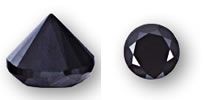 Diamonds with black as the primary dominant color are unique. Black diamonds, also known as carbon diamonds, owe their color to minute inclusions and random clustering throughout the stone rather than trace elements like nitrogen, boron and hydrogen that produce color in most diamonds. The black fine-grained diamond aggregate have a unique luster that seems to emanate from sheer darkness because a pure black diamond has almost complete absorption of light.
Diamonds with black as the primary dominant color are unique. Black diamonds, also known as carbon diamonds, owe their color to minute inclusions and random clustering throughout the stone rather than trace elements like nitrogen, boron and hydrogen that produce color in most diamonds. The black fine-grained diamond aggregate have a unique luster that seems to emanate from sheer darkness because a pure black diamond has almost complete absorption of light.
 Black diamonds are usually opaque, unlike most of the “white” or other fancy colored diamonds, which are transparent. As a result, cut parameters are of little importance with black diamonds since light does not reflect or refract which produces the brilliance and fire in conventional diamonds. Black diamonds still display the wonderful ‘adamantine’ luster almost unique to diamond and of course have the hardness and durability that is desirable as a gemstone.
Black diamonds are usually opaque, unlike most of the “white” or other fancy colored diamonds, which are transparent. As a result, cut parameters are of little importance with black diamonds since light does not reflect or refract which produces the brilliance and fire in conventional diamonds. Black diamonds still display the wonderful ‘adamantine’ luster almost unique to diamond and of course have the hardness and durability that is desirable as a gemstone.
 The rare pure specimens can command huge prices but the more common class of black diamonds have streaks that are colorless or gray which lead to pitted surfaces. These diamonds are comparatively reasonably priced (in the high four to low five figures per carat).
The rare pure specimens can command huge prices but the more common class of black diamonds have streaks that are colorless or gray which lead to pitted surfaces. These diamonds are comparatively reasonably priced (in the high four to low five figures per carat).
Two of the most famous black diamonds are the 202.00 carat Black Star of Africa and the 67.50 carat Black Orfloff.
Physical Characteristics
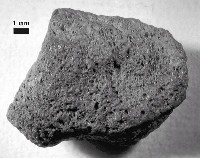 Black diamonds have unusual physical characteristics such as being composed of millions of diamond crystals stuck together and being porous as if formed in a gaseous froth. Traditional diamonds form as large crystals with classic crystal structure. Black diamonds look more like the obsidian (glassy black) or pumice (gray and full of holes) that result from volcanoes. The porous material is full of bubbles that appear to result from gases present when the diamonds formed. Conventional diamonds, formed deep within the earth, were the high pressure does not allow gases to exist.
Black diamonds have unusual physical characteristics such as being composed of millions of diamond crystals stuck together and being porous as if formed in a gaseous froth. Traditional diamonds form as large crystals with classic crystal structure. Black diamonds look more like the obsidian (glassy black) or pumice (gray and full of holes) that result from volcanoes. The porous material is full of bubbles that appear to result from gases present when the diamonds formed. Conventional diamonds, formed deep within the earth, were the high pressure does not allow gases to exist.
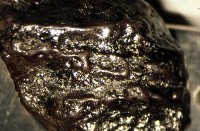 Black diamonds are seldom used as gemstones because they are extremely hard to cut and polish. They seem to have a hardness that exceeds conventional diamonds due to the fact they do not cleave along crystal plains. As a result, carbonado only cuts regular diamond powder with extreme difficulty. This trait makes it ideal for grinding, drilling and other industrial uses but not popular for uses in the jewelry industry.
Black diamonds are seldom used as gemstones because they are extremely hard to cut and polish. They seem to have a hardness that exceeds conventional diamonds due to the fact they do not cleave along crystal plains. As a result, carbonado only cuts regular diamond powder with extreme difficulty. This trait makes it ideal for grinding, drilling and other industrial uses but not popular for uses in the jewelry industry.
The secondary hues and color modifiers for black diamonds are gray, white, etc.
Source Locations
Black diamonds were originally named “carbonados” by Brazilian garimpeiros (small-scale independent miners) who discovered them in quantity in 1840. Common names for black diamonds include jet black, gun metal black, etc.
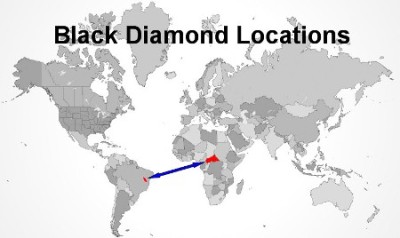
Black diamonds are found in Brazil and the Central African Republic but not in conventional diamond mining locations. They are not mined in Russia, Australia, Canada, or other African countries that are the primary sources of the 600 tons of conventional diamonds that have been mined over the last century. Since conventional diamonds formed deep in the earth’s crust, geologists have been challenged to explain why black diamond sources are so isolated and separate from conventional diamond locations.
Conventional diamonds are found in kimberlite pipes where they come to the surface from deep inside the earth’s crust and they are found in alluvial deposit where rivers have washed the stones until they collect in low-lying pockets or on the ocean floor where they are mined today. However, black diamonds are only found in alluvial deposits and not in any volcanic pipe, which implies they might not be formed deep in the earth like conventional diamonds.
 In 2006, a team of geologists led by Stephen Haggerty of Florida International University in Miami presented the results of a study that proposes that black diamonds came from outer space. The team theorizes that an asteroid about half mile in diameter collided with earth billions of years ago where South America and Africa were once connected landmasses. Today the deposits of black diamonds are thousands of miles apart because the landmasses drifted apart. While not all scientist and geologist accept the theory that black diamonds come from outer space, it does explain why black diamonds seem to have different physical characteristics than conventional diamonds and why they have not been found in kimberlite pipes as are regular diamonds formed inside the earth’s crust.
In 2006, a team of geologists led by Stephen Haggerty of Florida International University in Miami presented the results of a study that proposes that black diamonds came from outer space. The team theorizes that an asteroid about half mile in diameter collided with earth billions of years ago where South America and Africa were once connected landmasses. Today the deposits of black diamonds are thousands of miles apart because the landmasses drifted apart. While not all scientist and geologist accept the theory that black diamonds come from outer space, it does explain why black diamonds seem to have different physical characteristics than conventional diamonds and why they have not been found in kimberlite pipes as are regular diamonds formed inside the earth’s crust.
As the public becomes more aware that black diamonds might have come from outer space, their stellar origin might increase their popularity as a gemstone. Owning a diamond from outer space might be just the marketing theme that changes how diamond shoppers perceive this unique form of diamond.
Treatments
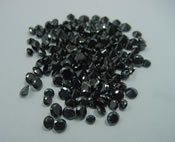 There are two basic treatments to color a diamond black: Irradiation and High-Temperature annealing. Natural black color is the result of black inclusions such as graphite or iron. Diamonds treated with irradiation are actually deep, dark green in color. The high temperature (HT) treatment conducted on natural diamonds under low oxygen conditions causes the carbon in the diamond to change phase toward graphite. Natural black diamonds have needle-like and irregular shaped inclusions scattered throughout the stone while inclusions in heat-treated diamond will have the inclusions concentrated near the surface. It is the black “lining” of graphite near the surface and along the internal fractures of the diamond, which produces the black appearance in heat-treated form of black diamonds.
There are two basic treatments to color a diamond black: Irradiation and High-Temperature annealing. Natural black color is the result of black inclusions such as graphite or iron. Diamonds treated with irradiation are actually deep, dark green in color. The high temperature (HT) treatment conducted on natural diamonds under low oxygen conditions causes the carbon in the diamond to change phase toward graphite. Natural black diamonds have needle-like and irregular shaped inclusions scattered throughout the stone while inclusions in heat-treated diamond will have the inclusions concentrated near the surface. It is the black “lining” of graphite near the surface and along the internal fractures of the diamond, which produces the black appearance in heat-treated form of black diamonds.
 In the 1990’s small black diamonds became very popular for use in jewelry with patterns of contrasting small black and white or yellow diamonds. Because natural black diamonds are relatively rare and difficult to cut and polish, treated diamonds filled the demand for the small black stones. The cost to cut hundreds or thousands of precisely sized pave natural black diamonds is much higher than the cost of the black stones used in jewelry today. As a result, you can almost assume that small black diamonds used in pave set jewelry will be treated diamonds and not natural black diamonds.
In the 1990’s small black diamonds became very popular for use in jewelry with patterns of contrasting small black and white or yellow diamonds. Because natural black diamonds are relatively rare and difficult to cut and polish, treated diamonds filled the demand for the small black stones. The cost to cut hundreds or thousands of precisely sized pave natural black diamonds is much higher than the cost of the black stones used in jewelry today. As a result, you can almost assume that small black diamonds used in pave set jewelry will be treated diamonds and not natural black diamonds.
Several simple tests can distinguish treated from natural black diamonds.
- When the edges of black diamonds are examined with a strong maglite or fiber-optic light, natural black diamonds will appear black but treated diamonds will have a deep brown or greenish tint.
- When the facet joints are examined with a standard 10x loupe, natural black diamonds will display even color but treated diamonds will display uneven, spotty color.
- Some treatments used to change a diamonds color to black alter the stones electrical conductivity. Therefore, even though the treated stone is a real diamond, when it is tested with a electrical conductivity measurement device (not just a thermal conductivity device), the tool indicates the stone is not a diamond.
